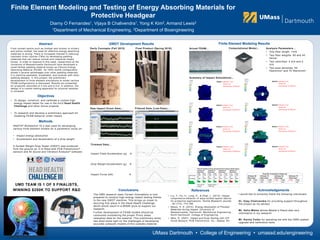
Sigma Xi Poster
- 1. UMass Dartmouth • College of Engineering • umassd.edu/engineering Abstract Objectives Methods GWDT Development Results Conclusions References Acknowledgements From contact sports such as football and hockey to military and police combat, the need for effective energy absorbing materials is strong. There is increased interest in reducing traumatic brain injuries (TBIs) by developing padding materials that can reduce normal and rotational impact forces. In order to respond to this need, researchers at the University of Massachusetts Dartmouth have developed a novel helmet padding material known as Fibrous Energy Absorbing Material (FEAM). Its 100% textile configuration allows it several advantages over other padding materials. It is machine washable, breathable, and modular with other padding designs. In this project, the preliminary development of finite element simulations to model various FEAM configurations is discussed. Results are presented for projectile velocities of 3 m/s and 5 m/s. In addition, the design of a custom testing apparatus for physical samples is reviewed. ANSYS® Workbench 16.2 was used for developing various finite element models for a parametric study on: • Impact energy absorption • Acceleration and deceleration of a drop weight A Guided Weight Drop Tester (GWDT) was produced from the ground up. It is fitted with PCB Piezotronics® sensors and NI Sound and Vibration Analysis® software. Summary of Impact Simulations… The UMD research team Corsair Innovations is now prepared to conduct high-energy impact testing thanks to the new GWDT machine. This brings us closer to securing first place in the Head Health Challenge, which would result in a $500K prize to support our research. Further development of FEAM models should be conducted considering the proper Prony shear relaxation data for the material. This preliminary study has shed some light on the challenges of developing accurate computer models of this complex material. • Liu, Y., Hu, H., Long, H., & Zhao, L. (2012). Impact compressive behavior of warp-knitted spacer fabrics for protective applications. Textile Research Journal , 82 (773), 774-788. • Matos, H. D. (2014). Energy Absorption of Flocked Materials during Impact. University of Massachusetts, Dartmouth, Mechanical Engineering. North Dartmouth: College of Engineering. • Metz, R. (2007). Impact and Drop Testing with ICP Force Sensors. PCB Piezotronics, Inc., Depew, NY. • To design, construct, and calibrate a custom high energy impact tester for use in the third Head Health Challenge and other future projects • To research and develop a preliminary approach for modeling FEAM behavior under impact I would like to sincerely thank the following individuals: Dr. Vijay Chalivendra for providing support throughout the project as my advisor Mr. Helio Matos whose Master’s thesis was very informative in my research Mr. Karoly Fodor for assisting me with the GWD system upgrade and calibration tests 1Department of Mechanical Engineering, 2Department of Bioengineering Diarny O Fernandes1, Vijaya B Chalivendra1, Yong K Kim2, Armand Lewis2 Finite Element Modeling and Testing of Energy Absorbing Materials for Protective Headgear UMD TEAM IS 1 OF 5 FINALISTS, WINNING $250K TO SUPPORT R&D Early Concepts (Fall 2015) Finite Element Modeling Results Model 1. Velocity: 3 m/s Denier: 60 Area Density: 70 fib/mm2 Final Product (Spring 2016) Raw Impact Event Data… Filtered Data (Low-Pass)… Actual FEAM… Computational Model… Analysis Parameters… • One fiber length: 1mm • Two fiber weights: 60 and 45 denier • Two velocities: 3 m/s and 5 m/s • Two area densities: 50 fibers/mm2 and 70 fibers/mm2 Model 2. Velocity: 3 m/s Denier: 60 Area Density: 50 fib/mm2 Model 3. Velocity: 3 m/s Denier: 45 Area Density: 70 fib/mm2 Model 4. Velocity: 3 m/s Denier: 45 Area Density: 50 fib/mm2 Model 5. Velocity: 5 m/s Denier: 60 Area Density: 70 fib/mm2 Model 6. Velocity: 5 m/s Denier: 60 Area Density: 50 fib/mm2 Model 7. Velocity: 5 m/s Denier: 45 Area Density: 70 fib/mm2 Model 8. Velocity: 5 m/s Denier: 45 Area Density: 50 fib/mm2 Impact Plate Acceleration (g) Drop Weight Acceleration (g) Impact Force (kN) Trimmed Data…